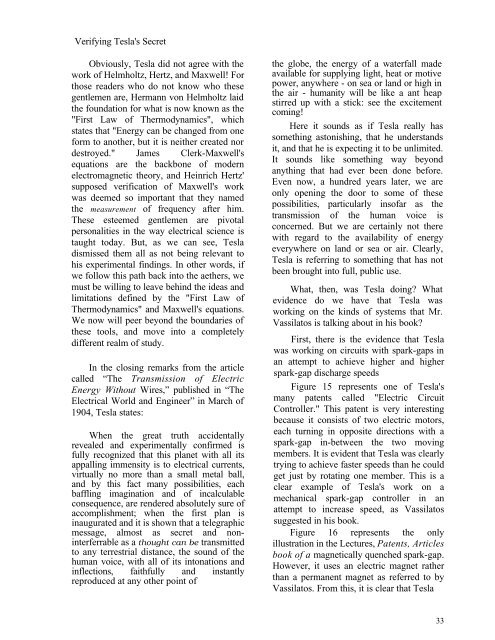Free%20Energy%20Secrets%20with%20Tesla%20patents
Free%20Energy%20Secrets%20with%20Tesla%20patents
Free%20Energy%20Secrets%20with%20Tesla%20patents
You also want an ePaper? Increase the reach of your titles
YUMPU automatically turns print PDFs into web optimized ePapers that Google loves.
Verifying Tesla's Secret<br />
Obviously, Tesla did not agree with the<br />
work of Helmholtz, Hertz, and Maxwell! For<br />
those readers who do not know who these<br />
gentlemen are, Hermann von Helmholtz laid<br />
the foundation for what is now known as the<br />
"First Law of Thermodynamics", which<br />
states that "Energy can be changed from one<br />
form to another, but it is neither created nor<br />
destroyed." James Clerk-Maxwell's<br />
equations are the backbone of modern<br />
electromagnetic theory, and Heinrich Hertz'<br />
supposed verification of Maxwell's work<br />
was deemed so important that they named<br />
the measurement of frequency after him.<br />
These esteemed gentlemen are pivotal<br />
personalities in the way electrical science is<br />
taught today. But, as we can see, Tesla<br />
dismissed them all as not being relevant to<br />
his experimental findings. In other words, if<br />
we follow this path back into the aethers, we<br />
must be willing to leave behind the ideas and<br />
limitations defined by the "First Law of<br />
Thermodynamics" and Maxwell's equations.<br />
We now will peer beyond the boundaries of<br />
these tools, and move into a completely<br />
different realm of study.<br />
In the closing remarks from the article<br />
called “The Transmission of Electric<br />
Energy Without Wires,” published in “The<br />
Electrical World and Engineer” in March of<br />
1904, Tesla states:<br />
When the great truth accidentally<br />
revealed and experimentally confirmed is<br />
fully recognized that this planet with all its<br />
appalling immensity is to electrical currents,<br />
virtually no more than a small metal ball,<br />
and by this fact many possibilities, each<br />
baffling imagination and of incalculable<br />
consequence, are rendered absolutely sure of<br />
accomplishment; when the first plan is<br />
inaugurated and it is shown that a telegraphic<br />
message, almost as secret and noninterferrable<br />
as a thought can be transmitted<br />
to any terrestrial distance, the sound of the<br />
human voice, with all of its intonations and<br />
inflections, faithfully and instantly<br />
reproduced at any other point of<br />
the globe, the energy of a waterfall made<br />
available for supplying light, heat or motive<br />
power, anywhere - on sea or land or high in<br />
the air - humanity will be like a ant heap<br />
stirred up with a stick: see the excitement<br />
coming!<br />
Here it sounds as if Tesla really has<br />
something astonishing, that he understands<br />
it, and that he is expecting it to be unlimited.<br />
It sounds like something way beyond<br />
anything that had ever been done before.<br />
Even now, a hundred years later, we are<br />
only opening the door to some of these<br />
possibilities, particularly insofar as the<br />
transmission of the human voice is<br />
concerned. But we are certainly not there<br />
with regard to the availability of energy<br />
everywhere on land or sea or air. Clearly,<br />
Tesla is referring to something that has not<br />
been brought into full, public use.<br />
What, then, was Tesla doing? What<br />
evidence do we have that Tesla was<br />
working on the kinds of systems that Mr.<br />
Vassilatos is talking about in his book?<br />
First, there is the evidence that Tesla<br />
was working on circuits with spark-gaps in<br />
an attempt to achieve higher and higher<br />
spark-gap discharge speeds<br />
Figure 15 represents one of Tesla's<br />
many patents called "Electric Circuit<br />
Controller." This patent is very interesting<br />
because it consists of two electric motors,<br />
each turning in opposite directions with a<br />
spark-gap in-between the two moving<br />
members. It is evident that Tesla was clearly<br />
trying to achieve faster speeds than he could<br />
get just by rotating one member. This is a<br />
clear example of Tesla's work on a<br />
mechanical spark-gap controller in an<br />
attempt to increase speed, as Vassilatos<br />
suggested in his book.<br />
Figure 16 represents the only<br />
illustration in the Lectures, Patents, Articles<br />
book of a magnetically quenched spark-gap.<br />
However, it uses an electric magnet rather<br />
than a permanent magnet as referred to by<br />
Vassilatos. From this, it is clear that Tesla<br />
33












![[Pham_Sherisse]_Frommer's_Southeast_Asia(Book4You)](https://img.yumpu.com/38206466/1/166x260/pham-sherisse-frommers-southeast-asiabook4you.jpg?quality=85)




